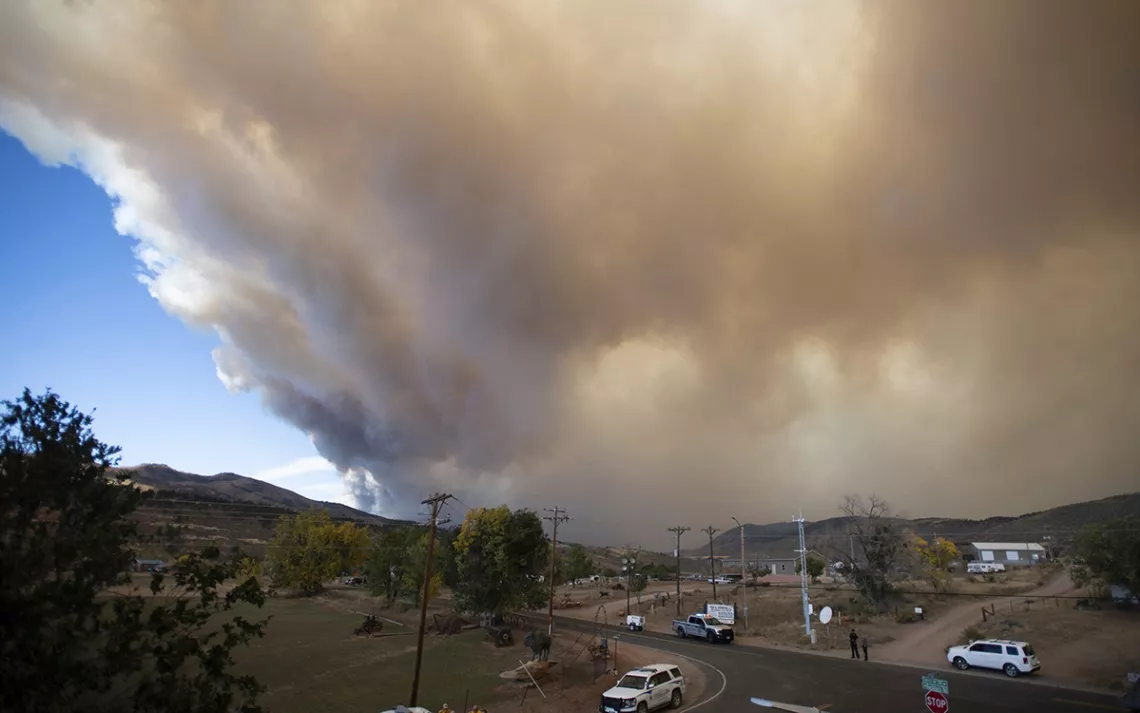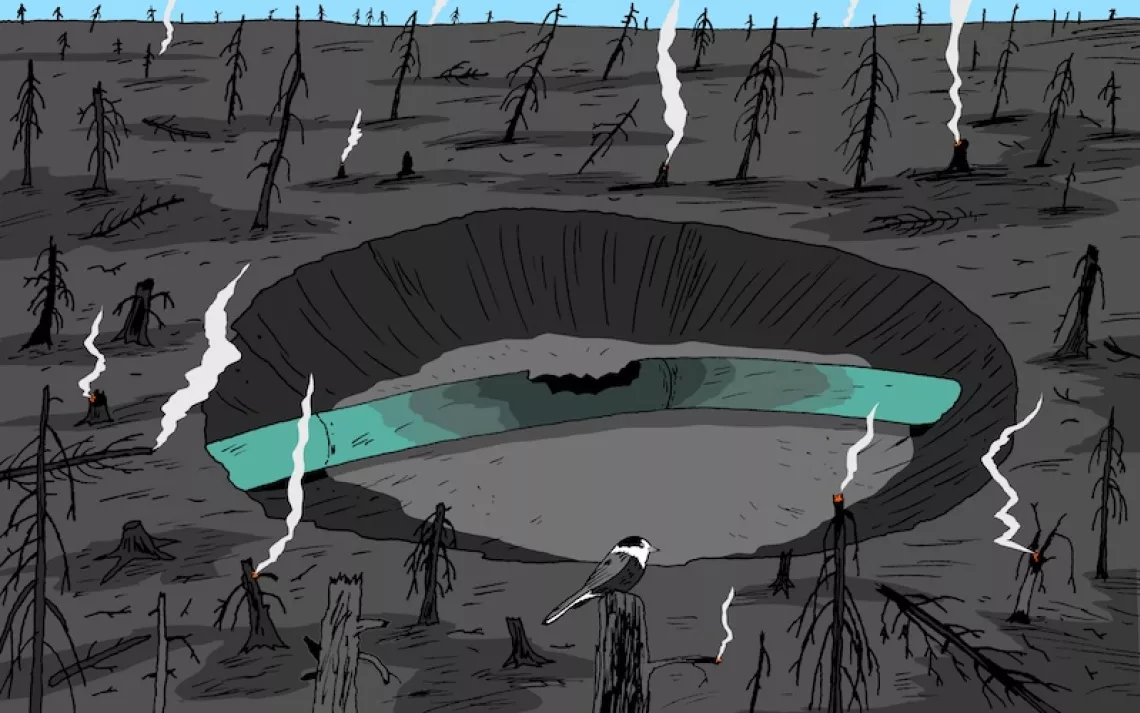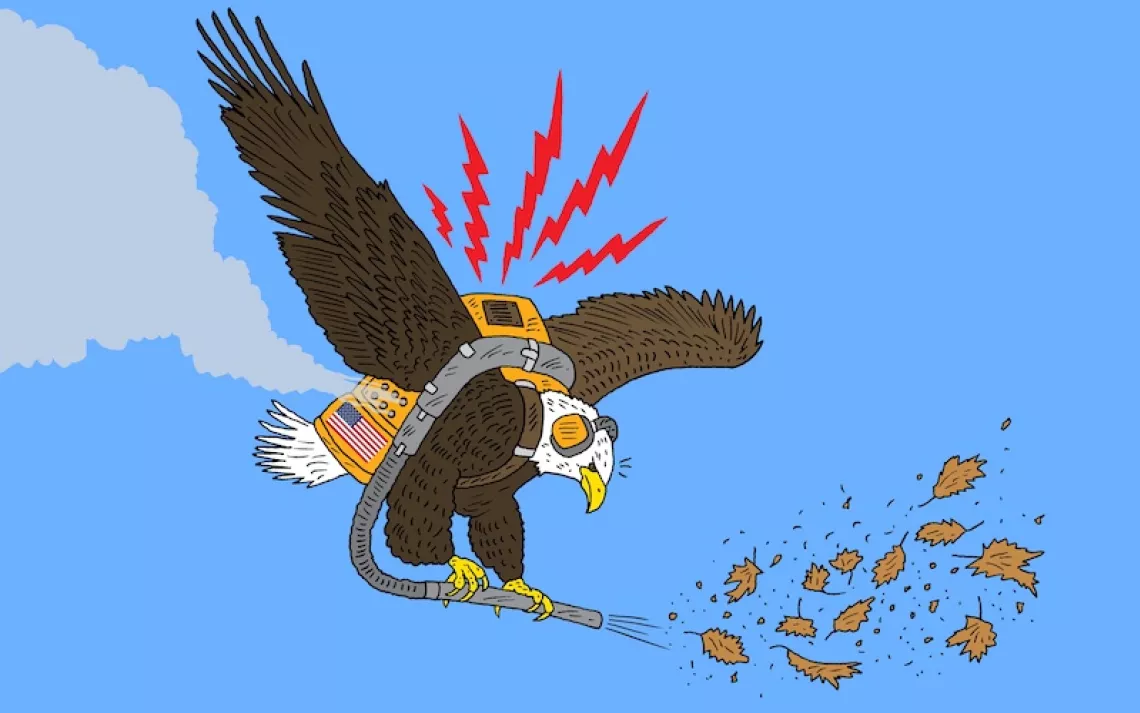The Fires of the Past Foretell the Fires of the Future
A Colorado resident reflects on the new normal of fire season

Smoke from the Cameron Peak Fire in Masonville, Colorado, on October 14, 2020. | Photo by Bethany Bakers/Fort Collins Coloradoan via AP Photo
It’s only June and there are already red-flag warnings all over western Colorado, meaning wildfire danger is high. A hot wind is blowing and temperatures are heading toward 105-plus degrees in the western part of the state. There is little chance of rain anywhere in Colorado in the weather forecasts.
Red-flag fire danger days in early summer. Hot and dry days, hotter and drier than anyone has seen before. Smoke-filled skies. This is our new-ish Colorado reality, brought to us by the fossil fuel industry.
During the past two decades, we Coloradans have gotten used to billowing clouds of smoke over the mountains in summer. But 2020’s fires broke records—and seemed to usher in a whole new and terrifying “normal.” Threats of fire usually are over by October, once we’ve received a snowfall or two. But not last year. In late October, we still had two major fires obscuring the sky and polluting our air. There was the Cameron Peak Fire—the largest in Colorado history—along with the Cal-Wood Fire—a fast-moving Boulder County conflagration.
I remember so clearly what it was like on the afternoon of October 21. I was out for a walk around east Boulder when I saw the smoke from the Cameron Peak and Cal-Wood Fires. I was already accustomed to those fires. I had watched flames on the hillsides northwest of Boulder at night, orange tongues of flame leaping up into the dark sky, the ponderosa pines bursting into flames, and the smoke. Always, the smoke. The fires had become a backdrop of sorts, our new Rocky Mountain normal.
Then I looked to the west and saw that a giant plume of smoke loomed above the Continental Divide. I was confused—where did that fire come from? The mass of clouds was ominous—if this were a thunderstorm, I’d hurry for home. But with its billowing orange-gray hue, the ugliest color on Earth, I knew it was a fire, a new one. Another Colorado forest was burning up. That third fire had to be located on the Continental Divide, which sits 20 miles west of Boulder. It’s above timberline up there, with only tundra and no trees. I’d never heard of a fire that high, at 12,000 feet. Until that day.
The Troublesome Gulch Fire, a relatively inconsequential blaze, had been burning on the western side of the Divide for a week by then. Fanned by strong, dry winds, on October 21 the Troublesome blew up and burned through the small town of Grand Lake, killing two people. It destroyed hundreds of homes, then sprinted up the steeply forested western slopes of Rocky Mountain National Park as it raged up and over 12,000-foot ridges and peaks and down into serene Odessa Lake, all old friends to Colorado hikers and backpackers. The fire closed our favorite national park, pushed thousands of residents from their homes, and filled the sky with more orangish-gray, pulsating smoke.
The fire had been negligible when it first began on October 14 (again, October!), but as it surged through Rocky Mountain National Park, it burned 6,000 acres per hour. Over the next day, it scorched over 100,000 acres, ultimately becoming Colorado’s second-largest fire ever. It was the first fire I’d ever heard of that had leaped over the tundra on the high Continental Divide, carried by the hot, dry wind from our continent’s western to eastern watersheds. This in itself was terrifying. We always had been able to trust that fires couldn’t cross over tundra and high peaks. Not anymore.
This new fire normal is so abnormal. I was born in Colorado. As a child, I never saw fires like these. My father was born here as well. He was stunned by the fires of 19 years ago, when in 2002 much of the state was on fire. “I’ve never seen anything like this,” he told me then. He was speaking in particular of the Hayman Fire that burned through Jefferson County that year. The Hayman probably shortened his life—he lived downwind of the fire, and he couldn’t help but inhale a lot of smoke. A short 18 months after the Hayman Fire, my dear father died.
Check out the history of Colorado’s fires and you’ll see that my daddy wasn’t exaggerating: The fires are far worse now. Until 1950, Colorado fires were little affairs—300 acres, 135 acres, at most 2,000 acres burned. In 1950, Colorado’s Cheyenne Mountain Fire, up until then the biggest in Colorado history, burned 28,000 acres. The Hayman Fire of 2002 burned 137,760 acres and for years was known as Colorado’s biggest fire. Jump to 2020 and all of our notable fires require six digits now: the Cameron Peak Fire (208,664 acres burned, the largest in Colorado history); the Troublesome Gulch (193,812 acres burned); the Mullen Fire (176,878 acres burned). With each conflagration, firefighters and local residents are injured or killed. Homes and businesses and livelihoods are lost. Incalculable numbers of animals and butterflies and birds and snakes and wildflowers and shaded glens are annihilated.
In part, these huge infernos are caused by decades of bad fire management, which allowed a lot of trees to become fuel for super fires. But these fires also occur because the American West is drier and hotter than it has ever been in recorded history. And these hotter and drier conditions are connected to global climate change and the continued reckless exploitation of fossil fuels. There’s a clear human fingerprint to be found on these newly intensified fires: the fingerprints of the oil, coal, and gas corporations. For decades, the fossil fuel industry ridiculed climate science and in the process limited our energy choices and kept consumers captive in an unsustainable lifestyle, forcing us all to be emitters of carbon dioxide and other greenhouse gases.
As a result, many of us Westerners now spend more of our summers inside, retreating from the heat and smoke. But wild animals have no “inside” to retreat to. Billions of animals died in early 2020 in Australia’s fires. Countless animals perish each year in fires across the American West.
I feel angry each year now as the fire season begins, and I’m not the only one. We should be able to go outside—it’s a pretty natural thing to want to do. I also feel fear for our community. The city of Boulder has been largely spared so far from wildfires, but our mountain communities have been hit hard with hundreds of homes lost to fire in the surrounding county.
For at least part of this summer, Coloradans will again endure smoke-filled skies from fires in Montana, Wyoming, Arizona, California, depending on which way the wind blows. And as our Colorado forests burst into flames this summer, people in other states will have to endure the smoke of our fires. Colorado is part of a global trend, one which scientists have predicted for more than 50 years and which has been ignored by the fossil fuel industry for just as long.
As anyone who lives in the West now knows all too well, the fires and the smoke make it nearly impossible to breathe. They have left us suffocating on the fossil fuel industry’s decades-long dismissal of scientific facts. This year, my household invested in electric heat pumps and a plug-in hybrid car—our way of doing our small part to tackle the root causes of the climate crisis and the intensifying fires. We spent a lot of money to do what the fossil fuel industry refuses to do: move on from oil, gas, and coal—the original sparks of the fires we now have to endure.
 The Magazine of The Sierra Club
The Magazine of The Sierra Club







